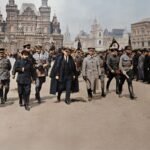Earth News
- Home
- Earth News


- A team of researchers led by the Nanjing Institute of Geology and Paleontology of the Chinese Academy of Sciences (NIGPAS), in collaboration with colleagues from Shanghai Jiao Tong University, the University of Bristol, and Nanjing University, has identified the primary non-environmental factors controlling lithium-to-magnesium ratio (Li/Mg) fractionation. Their findings were recently published in Earth and Planetary Science Letters.
- Tropical storms such as typhoons, hurricanes, and cyclones are Earth's most powerful weather systems. Born over warm oceans, they travel thousands of kilometers to land, traversing waters now polluted with plastics, from coastal runoff to the vast oceanic garbage patches.
- Glacial earthquakes are a special type of earthquake generated in cold, icy regions. First discovered in the Northern Hemisphere more than 20 years ago, these quakes occur when huge chunks of ice fall from glaciers into the sea.
- Much of the heavy rains that hit the Philippines during the Amihan northeast monsoon season between November and March are triggered by "shear lines": kilometers-long bands of converging warm and cold air that are constantly shifting and difficult to spot even via satellite.
- The climate is changing and nowhere is it changing faster than at Earth's poles. Researchers at Penn State have painted a comprehensive picture of the chemical processes taking place in the Arctic and found that there are multiple, separate interactions impacting the atmosphere.
- In April 2025, the Main Marmara Fault below the Sea of Marmara in northwestern Türkiye experienced its largest earthquake in over 60 years. In a study published in Science, a team of researchers led by Prof. Dr. Patricia Martínez-Garzón from the GFZ Helmholtz Center for Geosciences in Potsdam, Germany, analyzes nearly two decades of seismic data framing the 2025 April magnitude M 6.2 earthquake.
- Droughts are lasting longer in Australia, particularly in some of our most populated regions, UNSW scientists have shown.
- Researchers at the Institute for Meteorology at Leipzig University have, for the first time, determined the climatic impact of contrails that form within natural cirrus clouds. Contrails account for the largest share of aviation's climate impact beyond carbon dioxide emissions.
- In the wake of a wildfire, a vital micronutrient can become a toxic heavy metal—and could eventually make its way into groundwater.
- If it were to melt completely, the vast West Antarctic Ice Sheet (WAIS) holds enough ice to raise the global sea levels by 4 to 5 meters (13 to 16 feet).
- A team from the Centro Nacional de Investigación sobre la Evolución Humana (CENIEH) has collaborated with researchers from the University of Málaga (UMA) and the University of Córdoba (UCO) on an article published in the Journal of Sedimentary Research, which examines the relationship between the shape of sand grains and the distance traveled in the Arlanzón River (Burgos) and the Guadalhorce River (Málaga).
- Some 4.6 billion years ago, Earth was nothing like the gentle blue planet we know today. Frequent and violent celestial impacts churned its surface and interior into a seething ocean of magma—an environment so extreme that liquid water could not exist, leaving the entire planet resembling an inferno.
- Ammonia-oxidizing archaea (AOA) are some of the most abundant microorganisms in the ocean and play a key role in nitrogen cycling. Yet, despite their ubiquity, scientists have long puzzled over how these microbes can flourish in the nutrient-poor waters of the open ocean, where their main nitrogen and energy source, ammonium, is often vanishingly scarce.
- In an age of rising sea levels, as polar ice sheets melt in a climate warmed by fossil fuel emissions, climate modelers are racing to understand what the future might hold for coastlines around the world. But uncertainties about how fast polar ice might melt make predicting coastal inundation difficult. Now, scientists think they've helped make one of those uncertainties, the material conditions underneath the Greenland ice sheet, smaller.
- Around the world, phytoplankton in the upper ocean help to cycle key nutrients and regulate Earth's climate by absorbing carbon dioxide. These photosynthesizing organisms rely on dissolved iron as an essential micronutrient, meaning that when iron levels drop, phytoplankton activity drops, too.
- Sophisticated new chemical analysis of gases trapped in rocks for millions of years has cast new light on the origin of the gold deposits beneath Scotland and Ireland. The finding, made by team of scientists led by Professor Fin Stuart from the University of Glasgow, could help pinpoint the location of buried deposits of the treasured metal in the future.
- As part of the EU project ECOTIP, an international team of researchers, including the Helmholtz-Zentrum Hereon, has analyzed the sea off Greenland more comprehensively than ever before. The key question: How is the area developing in the face of climate change and environmental pollution? Most of the samples were examined in the Hereon laboratories.
- Recent fieldwork by Griffith University researchers has highlighted an African country that is facing a rapidly escalating environmental crisis as severe gully erosion—locally termed "mega gullies"—advances across valuable agricultural landscapes.
- Some wildfires are so intense, they create their own weather—thunderstorms driven by heat that hurtle smoke as high as 10 miles into the sky like giant chimneys.
- Asier Madarieta, a researcher in the EHU's HGI (Water Environmental Processes) group, has analyzed how the Earth's crust is being compressed and deformed in the field where Eurasia and Africa meet in the Western Mediterranean. His work contributes towards understanding this complex contact field better as well as opening the door to identifying the faults and structures that could lead to earthquakes or deformations on the peninsula.
Photographer:








